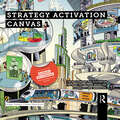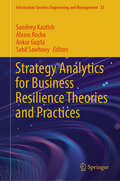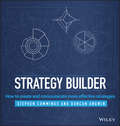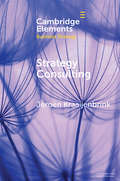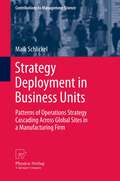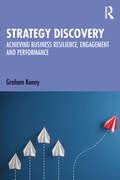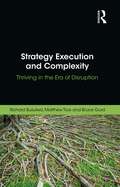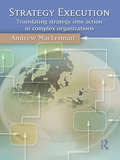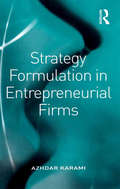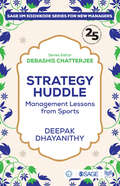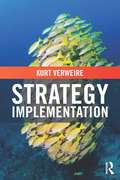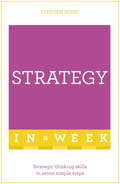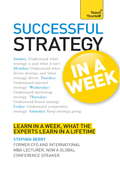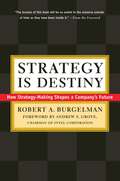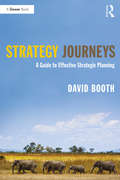- Table View
- List View
Strategy Activation Canvas
by Robert Wreschniok Ansgar ThiessenThe Strategy Activation Canvas is the new standard for accelerating strategies – beginning where classical strategies end: with its activation. While many management and business canvases focus on developing a strategy, the Strategy Activation Canvas helps leaders and decision-makers to bring strategies to life. This book demonstrates for the first time how entire organizations can be “activated”: how people can not only perceive and implement a new strategy, but how entire organizations can be heavily involved in its making, how strategies are made visible and experienced, and how people can play an active and sustaining role throughout bringing a strategy to life. With their decades of experience in large scale organizations, Thiessen and Wreschniok pair their knowledge with case studies from Allianz, Baloise, E.ON, Hamburg Commercial Bank, Microsoft, NORD/LB, Swisscom or Swiss Re, shared by leaders who have remarkably accelerated the success and value of their strategies on the back of strategy activation. This book is an essential resource for managers who have responsibility for strategic initiatives and transformation programs of any kind.
Strategy Analytics for Business Resilience Theories and Practices (Information Systems Engineering and Management #33)
by Ankur Gupta Álvaro Rocha Sandeep Kautish Sahil SawhneyA strategy is a blueprint of actions taken by managers to achieve the organization’s mission and vision and other long-term goals. In long term, strategy determines the success of an organization. While evaluating strategy, a company is essentially asking itself, “Where we are heading to and how we will achieve our goals?” Strategy Analytics is a relatively new field in conjunction with Strategic Management and Business Intelligence. Generally, Strategic Management field deals with the enhancement of the decision-making capabilities of managers. Typically, such decision-making processes are heavily dependent upon various internal and external reports. Managers need to develop their strategies using clear strategy processes supported by the increasing availability of data. This situation calls for a different approach to strategy, such as integration with analytics, as the science of extracting value from data and structuring complex problems. The term Strategic Analytics implies decisions are made, resources are invested, and plans for data and analytics are created based on the needs and critical questions a business is facing. The need for analytical solutions in today’s business environment is crucial because they allow users to think strategically about how an organization builds its core competencies and creates value. This not only informs the entire process, saves a lot of time, effort, and money, but also leads to value creation. This book will be one reference source to academic fraternity, management practitioners, business analysts and research students who are interesting in Strategic Analytics domain and using it in their research/practice work. In addition, the proposed book will be serving as state-of-art documentation of Strategy Analytics, its present role around organizational outcomes and outlines the need for greater integration in organization strategy and analytics for better strategic decision processes to measure corporate performance and business value creation. Distinguished Features of the proposed book State-of-art documentation of Strategy Analytics for Business Resilience and their applications for all levels of managerial positions. Excellent reference material for academic scientists, researcher and research scholars working in modern Strategy Analytics and Information Systems. This book will showcase the recent innovations, trends, and concerns as well as applied challenges encountered, and solutions adopted in the fields of Strategy Analytics
Strategy Beyond the Hockey Stick: People, Probabilities, and Big Moves to Beat the Odds
by Sven Smit Martin Hirt Chris BradleyWe’ve all seen hockey stick business plans before. A future where results sail confidently upward, but with a dip coinciding with next year’s budget. CEOs usually rely on their experience and business smarts to figure out which of those hockey sticks are real, and which are fake. But all too often getting to a “yes,” competing for resources, and striving to claim credit, cloud the hard decisions. Another strategy framework? No thanks, we already have plenty of those, and they don’t fix the real problem: the social dynamics in your strategy room. Mining the data from thousands of large companies, McKinsey Partners Chris Bradley, Martin Hirt and Sven Smit open the windows of that room, and bring an “outside view.” They found three discrete groups of companies: the bottom quintile with massive economic losses; the long, flat, middle 60 percent with practically no economic profit; and the top 20 percent to whom all the value accrues. Some companies do achieve real hockey stick performance: but just 1-in-12 jump from the middle tier to the top over a ten year period. This does not happen by magic—there is an empirically-backed science to improve your odds of success by capitalizing on your endowment, riding the right trends, and most importantly, making a few big moves. To make these big moves happen, you’re going to have to break through inertia, gamesmanship and risk aversion. You’re going to have to mitigate human biases and manage group dynamics. Eight practical shifts can help you do this, and unlock bigger, bolder, better strategies. This is not another by-the-book approach to strategy. It’s not another trudge through frameworks or small-scale case studies promising a secret formula for success. It’s an irreverent, fact-driven, and humorous take on the real world of strategic decision making.
Strategy Builder
by Duncan Angwin Stephen CummingsA visual and interactive guide to building and communicating strategies that actually work YOUR STRATEGY HAS SEVEN SECONDS TO CAPTIVATE ITS AUDIENCE... So how are you going to present it? A big wordy document? A lengthy address? Slides full of bullet points? The best way to engage and involve people is through pictures. Strategy Builder shows you how to creatively combine the best strategy frameworks to orient and animate strategy discussion and development in your team. This visual, interactive guide, with illustrations by Visory, uses real world examples and practical tips to help you: Discover the five key foundations that every strategy should be built upon Draw compelling and unique pictures that capture your organization's distinct strategies Develop your skills as a leader of strategy discussions Understand how to use interactive drawing to engage others and achieve 'buy in' For more information visit www.strategicplan.com Praise for Strategy Builder: Cummings & Angwin are pioneers in introducing novel approaches in teaching and applying the principles of strategy --Robert M. Grant, Bocconi University, author of Contemporary Strategy Analysis At last someone has grasped this idea and come up with a way to help us demonstrate strategic plans and ambitions in a creative new way. --Vikki Heywood CBE, Chair of The Royal Society for the Arts This wonderful book is the first to solve a near-universal problem: communicating strategic ideas is just as hard and just as important as coming up with them in the first place, and both are visual activities. The question is not "Do you understand?" but "Do you see?" --William Duggan, Professor, Columbia University, author Strategic Intuition This book shows how to draw an organization's strategy so you see what's been considered, what's not been considered, and how things are related,. Strategy building is presented as a fun and involving learning process.The approach is revolutionary in that it enables not only the development but also the easy sharing of strategic understanding. --Roger L.M. Dunbar, Emeritus Professor, Stern School of Business, New York University What a great idea! They layout is also really thoughtful; it makes you immediately want to get out a pencil and start doodling. --Adam Martin, Customer Solutions Director, The Brakes Group As a time pressed executive it was a delight to find a book that I can dip into to find the best strategic frameworks - those that have proved the test of time and academic scrutiny as being truly useful in the workplace. Even better for an inveterate scribbler: endorsement that a picture and 'permission to play' with ideas visually really does say a thousand words and more! --Sarah Mitson, Global Business Director, TNSGlobal This is an invaluable resource for any executive wanting to improve engagement in strategy development and communication. The accessible layout means that the book itself can play an active and inspiring role in strategy discussions. --Matt Thomas, Director, Braxton Associates, Strategy Consultants At last a book that grasps the implications of recent psychology: people think visually as well as verbally. The authors provide powerful visual devices that will both help managers conceive better strategies and enable their people to execute them more effectively. --Richard Whittington, Professor at Saïd Business School, Oxford University A powerful approach to make strategy more engaging again! Strategy Builder is landmark book is destined to make an important impact to the field of strategy, strategizing and strategic management. Executives across the board (and students of strategy) will find the core message of this book counterintuitive and compelling. The idea of "drawing" strategy may seem like child's play, yet all great strategists and philosophers know that it is through such "serious play" that allows us to see things differently so that we can see different things. --Robert Wright, Professor of Strategy, Hong Kong Polytechnic University
Strategy Consulting (Elements in Business Strategy)
by Jeroen KraaijenbrinkStrategy consulting is one of the most highly respected and at the same time deeply detested jobs on this planet. Despite all the attention and controversy, though, there is surprisingly little written about it specifically. To address this void, this Element provides a comprehensive overview of this fascinating and emerging profession. Relying on existing research and the author's practical experience, it describes what strategy consulting is, where it comes from, how to effectively practice it and where to take it into the future. Taking the position of the individual strategy consultant, it offers an insightful perspective that is useful for scholars, students, consultants and clients of strategy consulting. In doing so it moves away from the dominant corporate practice of analytical strategy consulting. Instead, it offers an idealized whole-brain and whole-person view on what strategy consulting could and should be like in order to fully live up its promise as a profession contributing to society.
Strategy Deployment in Business Units
by Maik SchlickelThis book reveals and presents the root-causes that lead to varying improvement performances across different locations of a global positioned manufacturing organization. Conducting a multiple case study analysis of manufacturing sites around the world, the author found that the quality of the strategy deployment process is vital, especially when it is clear to all affected employees--a situation we refer to as strategy cascading. But having a sound strategy cascading alone is not enough. The author worked out that a company, which achieves to align its sound strategy cascading with the company context and leadership style of its top-management team, is likely to realize more operations improvements than do companies that missed to do so.
Strategy Discovery: Achieving Business Resilience, Engagement and Performance
by Graham KennyPersonal, useful, actionable and grounded in research, this book will shift your thinking from "strategy development" to "strategy discovery" to enable you to deal with today’s business challenges, engage your staff and boost your business performance. Management teams and boards are facing disruption on all sides, from morphing customer preferences to the COVID pandemic to climate change. At the same time they are floundering in strategy confusion with too many concepts and not enough clarity. In this book, strategy expert and regular Harvard Business Review author Graham Kenny releases managers and directors from their strategy haze. His simple and effective framework allows managers to navigate the current maze of ideas and approaches and maximize their competitive advantage. Kenny’s readable style is equally effective: each chapter begins with an engaging story, then builds on this with cases, client examples, sidebars and more, ending with a series of action points to provide a pathway to success. CEOs, senior-level and middle managers across all functions and sectors, including private, public and not-for-profit organizations, who discuss and set strategy for their organization or business unit will appreciate the articulated framework, illustrative anecdotes and positive encouragement this book offers.
Strategy Discovery: Achieving Business Resilience, Engagement and Performance
by Graham KennyPersonal, useful, actionable and grounded in research, this book will shift your thinking from "strategy development" to "strategy discovery" to enable you to deal with today’s business challenges, engage your staff and boost your business performance. Management teams and boards are facing disruption on all sides, from morphing customer preferences to the COVID pandemic to climate change. At the same time they are floundering in strategy confusion with too many concepts and not enough clarity. In this book, strategy expert and regular Harvard Business Review author Graham Kenny releases managers and directors from their strategy haze. His simple and effective framework allows managers to navigate the current maze of ideas and approaches and maximize their competitive advantage. Kenny’s readable style is equally effective: each chapter begins with an engaging story, then builds on this with cases, client examples, sidebars and more, ending with a series of action points to provide a pathway to success. CEOs, senior-level and middle managers across all functions and sectors, including private, public and not-for-profit organizations, who discuss and set strategy for their organization or business unit will appreciate the articulated framework, illustrative anecdotes and positive encouragement this book offers.
Strategy Execution and Complexity: Thriving in the Era of Disruption
by Richard Busulwa Matthew Tice Bruce GurdAlmost all organisations today face unprecedented levels of change, complexity and volatility. Navigating the resultant disruption dynamics is one of the most important stewardship challenges facing strategic leaders. Getting it right can pay enormous dividends, but getting it wrong can lead to spectacular failure and the ultimate demise of once admired organisations. To address this threat, strategic leaders need to better understand how to navigate complexity and volatility and how to execute strategy in this rapidly changing environment. This book identifies 12 different strategy execution processes used to realise deliberate and emergent strategies – each illustrated with case studies and essential lessons for strategic leaders. The authors then discuss the effectiveness of these processes in different types of complex environments, showing how, used in isolation, each process can, at times, impede performance, sometimes creating survival risks that materialise today or in the future. The authors show the importance of "ambidexterity" and the need for organisations to balance the pursuit of internal efficiency and external market flexibility, both of which are essential to thriving in complex environments. This book provides essential tools for leaders to rethink and reconfigure their strategy execution practices in light of the significant change surrounding their organisations. The book is based on a 5-year, multistage study comprehensively reviewing cutting-edge research on strategy execution, reviewing seminal texts on strategy execution and, through in-depth case study interviews and cross-sectional surveys, identifying contemporary strategy execution practices of a range of different organisations across industries and sectors.
Strategy Execution: Translating Strategy into Action in Complex Organizations
by Andrew MacLennanStrategy execution is one of the most important and exciting topics in management. Implementing strategy in today's complex organizations is an enormous challenge but one that all leaders must tackle. This lively book is an essential guide to strategy execution for practicing managers and those in advanced management education. It combines the rigour of advanced research with the accessibility of practical experience and application to lead readers through the subject. Drawing together existing knowledge and reporting findings from his own research, Andrew MacLennan brings this often neglected topic sharply into focus. After introducing and defining strategy execution, the book presents a series of systematic frameworks to help managers and leaders: identify common strategy execution barriers and diagnose performance problems in particular situations translate conceptual strategies into concrete activities align emergent activities and projects with strategic objectives support critical activities by aligning organizational designs and systems Strategy Execution is an insightful, engaging and practical book. The models are supplemented throughout with real world examples, summaries of key issues and signposts to further readings. It is a comprehensive, easy to use book offering students and practitioners a systematic approach to strategy implementation.
Strategy Formulation and Inertia
by Giovanni GavettiDiscusses how strategy-makers should take organizational inertia into account in strategy formulation. Looks at two classes of inertia: cognitive inertia and action inertia. A rewritten version of an earlier case.
Strategy Formulation in Entrepreneurial Firms
by Azhdar KaramiThis book is concerned with strategy formulation issues in the relatively neglected field of entrepreneurial firms. It raises questions, such as what is the strategic role of entrepreneurship in small businesses? How does the top management in small firms perceive the processes associated with strategy formulation? How are business strategies formulated and implemented in SMEs and importantly, are there lessons that can be learnt by large corporations from the smaller ones? Using a sample covering a wide range of entrepreneurial firms in the UK, the author addresses the lack of strategic thinking in the management of small firms and provides recommendations for effective strategic management processes.
Strategy Genius: 40 Insights From the Science of Strategic Thinking
by Richard A JonesThe fast-track MBA in strategyImagine having instant access to the world's smartest thinking on strategy - and being shown exactly what to do to guarantee that you get your own strategy right, every time. Strategy Genius makes it easy to apply what researchers know about strategic thinking to the real world. 40 chapters based on hundreds of cutting-edge business and psychology research projects reveal what works and what doesn't work in strategy. Each of the 40 chapters is a mini-masterclass in strategic thinking, explaining the research and showing you how to apply it for yourself.In business, conventional wisdom often says one thing while research says another. Strategy Genius cuts through the noise to bring you proven research and techniques for applying it that will simply make you a better strategist.Quick to read and intensely practical, this book will bring a little strategy genius into your day.'Strategy is one of those topics that many people talk about without having much idea what they mean. Richard Jones is one of the exceptions. A very good book; I recommend it strongly' Peter Hiscocks, CEO Judge Business School Executive Education, University of Cambridge'Genius conflated into something you can understand. A bit like Richard, really' Michael Wilson, Director of Business and Economics Editor, Arise Global Networks
Strategy Genius: 40 Insights From the Science of Strategic Thinking
by Richard D JonesThe fast-track MBA in strategy Imagine having instant access to the world's smartest thinking on strategy - and being shown exactly what to do to guarantee that you get your own strategy right, every time. Strategy Genius makes it easy to apply what researchers know about strategic thinking to the real world. 40 chapters based on hundreds of cutting-edge business and psychology research projects reveal what works and what doesn't work in strategy. Each of the 40 chapters is a mini-masterclass in strategic thinking, explaining the research and showing you how to apply it for yourself. In business, conventional wisdom often says one thing while research says another. Strategy Genius cuts through the noise to bring you proven research and techniques for applying it that will simply make you a better strategist. Quick to read and intensely practical, this book will bring a little strategy genius into your day. 'Strategy is one of those topics that many people talk about without having much idea what they mean. Richard Jones is one of the exceptions. A very good book; I recommend it strongly' Peter Hiscocks, CEO Judge Business School Executive Education, University of Cambridge 'Genius conflated into something you can understand. A bit like Richard, really' Michael Wilson, Director of Business and Economics Editor, Arise Global Networks
Strategy Huddle: Management Lessons from Sports (SAGE IIM-Kozhikode Series for New Managers)
by Deepak DhayanithyThough Sun Tzu’s ‘Art of War’ was written 2,500 years back, strategy is seen as a young discipline in business management. Over the last half to three-fourths of a century, strategy has carved its own niche in the larger business management realm. Strategy Huddle: Management Lessons from Sports draws out significant strategic management knowledge from 27 different phenomena in diverse sports including soccer, basketball, marathon, boxing, chess and cricket. The practical applications of these strategies are shown through business case scenarios in this book. For new managers seeking to sharpen their strategic management concepts such as blue ocean, behavioural and network strategies as well as for strategic thinkers interested in understanding the deeper connections between strategy and sports, this book brings to the readers an enriching learning and strategic experience.
Strategy Implementation: A Guide To Strategy Implementation
by Kurt VerweireStrategy implementation - or strategy execution - is a hot topic today. Managers spend significant resources on consulting and training, in the hope of creating brilliant strategies, but all too often brilliant strategies do not translate into brilliant performance. This book presents new conceptual models and tools that can be used to implement different strategies. The author analyses how market leaders have benefitted from successful strategy implementation and provides the reader with a comprehensive and systematic framework to tackle strategy implementation challenges. Have clear strategic choices been made? Are actions aligned with the strategy? What’s the organizational context for the strategy? In answering these simple questions, the book provides students of strategic management, along with managers involved in designing and implementing strategies, with a valuable resource.
Strategy In A Week: Strategic Thinking Skills In Seven Simple Steps
by Stephen BerryStrategic thinking just got easierFor most aspiring managers, at some point in their careers, their Personal Development Plans will include the demand to have 'greater strategic thinking ability'. We have the perception that executives operating at board-level have this 'strategic thinking ability' but seldom find the route to obtain it for ourselves. The purpose of this book is to provide that route. Strategy, like any other discipline, can be learned and practised. This book takes you on a journey to explore what organizational strategy is, where it fits within the context of each business, and then gives an examination of internal, external, marketing, brand and competitive strategy. To progress to an executive position, a wide range of skills and attributes are required. Aspects such as good leadership skills, strong communication skills, commercial understanding and the ability to understand other people are all needed. Equal with these vital elements is the ability to have a good grasp of strategic thinking. Strategy In A Week provides the platform for you to acquire the vital skills of strategic thinking. Whether you choose to read it in a week or in a single sitting, this is your fastest route to success:- Sunday: Understand what strategy is and what it isn't- Monday: Understand what drives strategy and what strategy drives- Tuesday: Understand internal strategy- Wednesday: Understand marketing strategy- Thursday: Understand brand strategy- Friday: Understand competitive strategy- Saturday: Keep strategy going
Strategy In A Week: Strategic Thinking Skills In Seven Simple Steps
by Stephen BerryStrategic thinking just got easierFor most aspiring managers, at some point in their careers, their Personal Development Plans will include the demand to have 'greater strategic thinking ability'. We have the perception that executives operating at board-level have this 'strategic thinking ability' but seldom find the route to obtain it for ourselves. The purpose of this book is to provide that route. Strategy, like any other discipline, can be learned and practised. This book takes you on a journey to explore what organizational strategy is, where it fits within the context of each business, and then gives an examination of internal, external, marketing, brand and competitive strategy. To progress to an executive position, a wide range of skills and attributes are required. Aspects such as good leadership skills, strong communication skills, commercial understanding and the ability to understand other people are all needed. Equal with these vital elements is the ability to have a good grasp of strategic thinking. Strategy In A Week provides the platform for you to acquire the vital skills of strategic thinking. Whether you choose to read it in a week or in a single sitting, this is your fastest route to success:- Sunday: Understand what strategy is and what it isn't- Monday: Understand what drives strategy and what strategy drives- Tuesday: Understand internal strategy- Wednesday: Understand marketing strategy- Thursday: Understand brand strategy- Friday: Understand competitive strategy- Saturday: Keep strategy going
Strategy In A Week: Strategic Thinking Skills In Seven Simple Steps
by Stephen BerryThe ability to develop and implement a successful strategy is crucial to anyone who wants to advance their career. Written by Stephen Berry, a leading expert on strategy as both a coach and a practitioner, this book quickly teaches you the insider secrets you need to know to in order to build a winning strategy. The highly motivational 'in a week' structure of the book provides seven straightforward chapters explaining the key points, and at the end there are optional questions to ensure you have taken it all in. There are also cartoons and diagrams throughout, to help make this book a more enjoyable and effective learning experience. So what are you waiting for? Let this book put you on the fast track to success!
Strategy Is Destiny: How Strategy-Making Shapes a Company's Future
by Robert A. BurgelmanHow did a pioneering company in the semiconductor industry not only survive but thrive in the face of the explosive change and upheavals that forced it to transform itself twice in the course of its thirty-year history? The answer lies in the quality of its strategy-making process, contends leading strategic management scholar Robert A. Burgelman in this extraordinary book based on an exhaustive twelve-year study he conducted inside Intel Corporation. Granted the opportunity to track Intel's strategy-making through his close teaching collaboration with its chairman, Andy Grove, at Stanford Business School since 1988, Burgelman has written a definitive and far-reaching account of how highly educated top managers groped their way through strategic conundrums. His account of the evolution of key events in Intel's history is illustrated with extensive quotes from its cofounder Gordon Moore, Andy Grove, current CEO Craig Barrett, and dozens of other Intel executives. His study allows these leaders to speak for themselves in scores of highly rendered executive portraits. Using thoroughly tested conceptual tools, Burgelman first documents the key role played by mid-level managers in transforming Intel from a memory company into a microprocessor company during the late 1970s and early 1980s, which led to the heartbreaking decision to abandon the business on which the company had been founded in 1968. He then makes readers eyewitnesses to the complex set of complementary strategic thrusts orchestrated by Andy Grove to make Intel capi- talize on the extraordinary opportunities associated with the phenomenal growth of the PC industry during the late 1980s and the 1990s. He reconstructs Grove's resolution of the struggle between two competing micro- processor architectures within Intel that caused civil war to erupt, and he shows how Intel's superbly run strategy-making process in the core business, paradoxically, made it difficult for internal entrepreneurs to extend the company's strategic reach. This allows him to link the strategic leadership challenges, faced today by Craig Barrett, to Intel's illustrious past and to provide suggestions for how these challenges can be met. At once a history of strategy-making at Intel as well as a strategy-making field manual that any high-technology manager will need to consult frequently, Strategy Is Destiny truly describes strategy-in-action as the way of life of senior executives in the corporation of the future.
Strategy Is Destiny?: An Evidence-Based Approach to Strategy
by Robert I. Sutton Jeffrey PfefferThis chapter questions whether and when strategy is destiny and makes an evidence-based case that excessive faith in strategic decision making is hazardous to an organization's health.
Strategy Journeys: A Guide to Effective Strategic Planning
by David BoothStrategy Journeys starts from the premise that strategic planning suffers from a bad press: it can be seen as complex, technical, remote from the day-to-day reality of an organisation, undertaken by an elite specialist executive group, producing threatening changes whose rationale is barely understood – or, perhaps worse still, having no worthwhile impact at all.For many senior executives, strategic planning is too daunting a task, which is why they often seek help from those with the expertise to guide the process: they have a severe lack of confidence in their own ability to design, plan and implement such an important and major project.Yet organisations have never had greater need for a flexible, resilient and engaging approach to strategic planning than now. How do those leading an organisation know where to start, what approach to take and how to go about the process of strategic planning? David Booth aims to help them by demystifying the concept and propounding a ‘first principles’ approach to developing a strategic plan within the context of the individual organisation and with the flexibility to adapt the process to focus on what really matters. He suggests the key questions that should be asked when considering embarking on a strategic planning ‘journey’ to help design and guide the process.
Strategy Mapping for Learning Organizations: Building Agility into Your Balanced Scorecard
by Phil JonesHow can we ensure our strategy will succeed, especially in changing and uncertain times? The answer, as explained in Strategy Mapping for Learning Organizations, is to become a more responsive organization - one that captures its strategy in strategy maps, learns from that strategy and can adapt to deliver results. For anyone involved in managing strategy and performance, applying the powerful strategy mapping techniques will move your balanced scorecard from an operational tool to one of strategy and change. It will help you capture, communicate and manage your strategy more effectively. However, strategy can no longer be simply a top down, annual process. It needs to be more iterative, emergent and involving. Many agile organizations have adopted rolling plans and budgets. To bring greater agility into the wider strategy and performance management processes requires the tools and techniques described in Strategy Mapping for Learning Organizations. Phil Jones provides a detailed guide to developing, rolling out and managing with modern strategy maps and scorecards, building in agility and learning. His book incorporates the latest strategic thinking and models. It places the balanced scorecard in a wider governance context that includes the management of risk and environmental and social responsibility. Fully illustrated with examples from many different organizations, this book will help you deliver your strategy better.
Strategy Maps
by Robert S. Kaplan David P. NortonMore than a decade ago, Robert S. Kaplan and David P. Norton introduced the Balanced Scorecard, a revolutionary performance measurement system that allowed organizations to quantify intangible assets such as people, information, and customer relationships. Then, in The Strategy-Focused Organization, Kaplan and Norton showed how organizations achieved breakthrough performance with a management system that put the Balanced Scorecard into action.Now, using their ongoing research with hundreds of Balanced Scorecard adopters across the globe, the authors have created a powerful new tool--the "strategy map"--that enables companies to describe the links between intangible assets and value creation with a clarity and precision never before possible. Kaplan and Norton argue that the most critical aspect of strategy--implementing it in a way that ensures sustained value creation--depends on managing four key internal processes: operations, customer relationships, innovation, and regulatory and social processes. The authors show how companies can use strategy maps to link those processes to desired outcomes; evaluate, measure, and improve the processes most critical to success; and target investments in human, informational, and organizational capital. Providing a visual "aha!" for executives everywhere who can't figure out why their strategy isn't working, Strategy Maps is a blueprint any organization can follow to align processes, people, and information technology for superior performance.
Strategy Maps
by Robert S. Kaplan David P. NortonThe Balanced Scorecard strategy map provides a framework to illustrate how strategy links intangible assets to value-creating processes. Building a strategy map forces an organization to clarify the logic of how it will create value and for whom. This chapter describes the principles involved in building a strategy map. An illustrative case study is provided.
